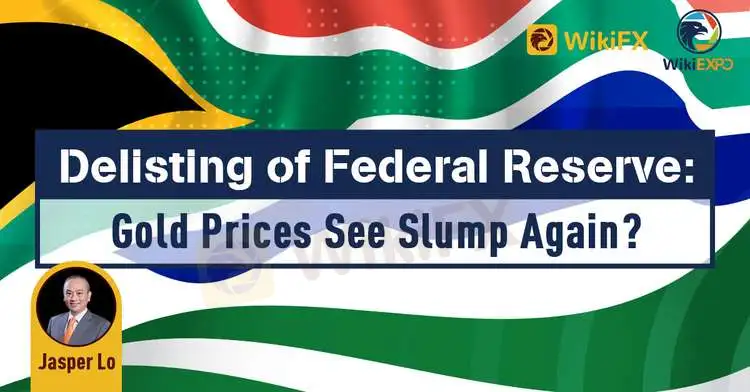简体中文
繁體中文
English
Pусский
日本語
ภาษาไทย
Tiếng Việt
Bahasa Indonesia
Español
हिन्दी
Filippiiniläinen
Français
Deutsch
Português
Türkçe
한국어
العربية
Delisting of Federal Reserve: Gold Prices See Slump Again?
Abstract:Gold prices have witnessed a steady decline in the wake of peaks since August last year even hit USD 1676.73 because of strong USD and the surge of the U.S. bond interests in the first quarter.

Gold prices have witnessed a steady decline in the wake of peaks since August last year even hit USD 1676.73 because of strong USD and the surge of the U.S. bond interests in the first quarter. Then they dramatically rebounded to USD 1916.57 as the currency turned to be weak and the inflation was worsening. However, this rally was interrupted and reversed by hawkish messages sent by the Federal Reserve (Fed) after its meeting last week. My friend who is an anchor asked me whether gold prices would experience staggering falls again after the delisting announced by the Fed this time as it did in 2013. Factors playing a dominant role in this concern are discussed herein.
Gold prices started to deadly decline after peaking at USD 1700 in early 2013 and hit USD 1180 in June. The main culprits for this are: on one hand, the Fed embarked on delisting at that time, naturally posing stress to gold prices under the context of the rally of USD; on the other hand, the Central Bank of Cyprus (CBC) attempted to sell out gold to take profits and save the market against the backdrop of the European debt crisis, exacerbating the comprehensive steep slump of gold prices.
At present, the Fed embraces the same opportunity to plan for delisting, which is expected to impose the same stress on gold prices. However, the difference is located in the situation where no central banks intend to sell out their gold reserves this time, causing less severe downward pressure to gold prices as it did in 2013. Currently, the global escalating inflation is conducive to gold as a hedge against its worsening to some extent. It is expected that some speculators may buy gold to ride a wave of the plummet in gold prices.

It is worth noticing that one reason for gold prices reaching a record high last year is that central banks worldwide issued more currencies for quantitative easing (QE), leading to the depreciation which was quite beneficial to gold prices. However, it is predicted that other main industrial powers may follow suit after the Bank of Canada (BOC), the Reserve Bank of New Zealand (RBNZ), and the Fed have turned to be hawkish. In fact, some nations have announced to increase interest rates, including Russia, Brazil, Iceland, Hungary, and the Czech Republic. As a result, gold prices can be affected adversely by interest-rate hikes worldwide and the global trend of delisting in the future to some extent.
In conclusion, influenced by all aforementioned factors conducive to the slump, gold prices may see the massive plunge rife with ups and downs again. The double bottom support level at USD 1676.73 is expected to be exceeded and reach USD 1557. As for the major support level for gold below, the view shared by all is the level at USD 1451, which is hard to say at present. However, it will absolutely a golden opportunity for investors to buy gold if its prices can fall back to this level.
Disclaimer:
The views in this article only represent the author's personal views, and do not constitute investment advice on this platform. This platform does not guarantee the accuracy, completeness and timeliness of the information in the article, and will not be liable for any loss caused by the use of or reliance on the information in the article.
Read more

Trading Psychology – 4 Wise Quotes From The Legendary Mark Douglas
In the world of trading, few books have had the impact of Mark Douglas’ big hit Trading in the Zone. Written almost two decades ago, the book has become a must-read for traders looking to elevate their game to legendary status. While there is so much wisdom to be found in the book, we’ve compiled 5 of the best quotes about trading psychology that every trader should read.

EUR/USD Forecast: New lows ahead of the weekend? ECB, covid and technical all point lower.
Optimism has been weighing on the safe-haven dollar – but not against the euro. The common currency's failure to recover is a sign of weakness that could be followed with falls to fresh lows once the mood sours again – and there are reasons to expect that to happen sooner rather than later.

EURJPY WEEKLY FORECAST. Price Likely To Rise Above 131.000.
The price of EURJPY has been on a steady rise ever since it made a low of 128.808. Other currencies collapsed against the Japanese Yen two weeks ago.

AUD Is Weak Under All-rounded Pressure
A rise in the wake of a fall was seen by DXY last week ascribed to the uncertain time of delisting caused by the Federal Reserve (Fed). However, the reason for the rally of DXY last Friday is the vigorous growth of personal consumption expenditures (PCE) released by the U.S. Bureau of Economic Analysis (BEA).
WikiFX Broker
Latest News
Spotware Unveils cTrader Store, Global Marketplace for Algo Creators
Elderly Trader Loses RM2.1M in WhatsApp Forex Scam
Gigamax Scam: Tracking Key Suspects in RM7 Million Crypto Fraud
CFI Partners with MI Cape Town, Cricket Team
Doo Financial Expands Reach with Indonesian Regulatory Licenses
WikiFX Review: Is IQ Option trustworthy?
5 Questions to Ask Yourself Before Taking a Trade
Quadcode Markets: Trustworthy or Risky?
Avoid Fake Websites of CPT Markets
Webull Canada Expands Options Trading to TFSAs and RRSPs
Currency Calculator


